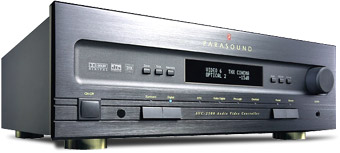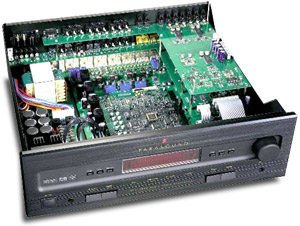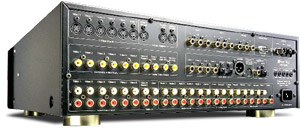
|

Parasound
AVC-2500u Surround-Sound
Processor

|
|
|
 |

DescriptionPrice: $3495 USD
Dimensions: 17.25"W x 5.25"H x
13"D
Weight: 16 pounds
Warranty: Ten year parts, five years labor
Features
- Full 24-bit processing using three Motorola 56009 processors
- Dolby Digital, DTS, Dolby Surround, and Home THX Ultra
certification
|

Features (continued)
- Independent dual-zone control of audio and video systems
- Composite-video, S-video, and Component-video switching
- Automatic digital audio and video input selection
- Digital inputs and surround modes are assignable to sources
- Intelligent on-screen display and backlit learning remote
control
- FM/AM stereo tuner with 20 presets
- External analog 5.1 inputs assure forward compatibility
|
I’ve had a few brushes with Parasound
amplifiers, and I’ve always been impressed with them. I’ve found them to be
smooth, refined, extraordinarily robust, and sold at very fair prices. Last winter I was
considering a new home-theater processor/preamp, and based on my earlier experience and on
its features, the Parasound AVC-2500 came to the top of the list. Circumstances quickly
changed, and I fell out of the market, but curiosity about the AVC-2500 persisted. The
AVC-2500 has changed from my first brush with it and is now called the
AVC-2500u.
Functionality
Most intriguing about this unit (other than its built-in
AM/FM tuner section) is its 100% automatic calibration of channel levels, including the
sub channel, via the use of an included microphone. As a reviewer, my systems are
constantly in flux, and every time I swap into the system a new set of speakers, I am
forced to drag out the SPL meter, search the on-screen menus and start cycling through the
test tones. It can get tiresome. What a joy I thought it would be to place a microphone in
the listening position, press a button or two and let the processor do all of that for me.
And not only is the SPL matched, the process also adjusts delay times too, which is pretty
cool.
 The AVC-2500u emits a series
of "clicks," which are picked up by the microphone. The unit analyzes the
interval between the processor’s sending of the "click" and the
microphone’s picking it up. It then calculates how far away from the speaker the
microphone is (and it even displays the measurement in feet) and adjusts delay to ensure
time alignment throughout the system. The AVC-2500u had a hard time locating my subwoofer
for some reason, but that was easy enough to fix. I got out my own tape measure, and using
the remote control, I dialed in the number of feet between the sub and me. Other than
that, the system worked flawlessly, and there’s an added measure of coherence to the
presentation you hear once the system is this finely balanced. Of course, if you prefer to
balance the channels the old fashioned way, by cycling noise through the channels with a
hand-held SPL meter and the remote control, you can do that too. The AVC-2500u emits a series
of "clicks," which are picked up by the microphone. The unit analyzes the
interval between the processor’s sending of the "click" and the
microphone’s picking it up. It then calculates how far away from the speaker the
microphone is (and it even displays the measurement in feet) and adjusts delay to ensure
time alignment throughout the system. The AVC-2500u had a hard time locating my subwoofer
for some reason, but that was easy enough to fix. I got out my own tape measure, and using
the remote control, I dialed in the number of feet between the sub and me. Other than
that, the system worked flawlessly, and there’s an added measure of coherence to the
presentation you hear once the system is this finely balanced. Of course, if you prefer to
balance the channels the old fashioned way, by cycling noise through the channels with a
hand-held SPL meter and the remote control, you can do that too.
What’s new about the AVC-2500u that sets it apart from
its predecessor is the bass-management system (which can be upgraded in the older unit for
a very reasonable fee). The original AVC-2500 had only one crossover point (80Hz), while
the AVC-2500u gives you a choice of four high- and low-pass-filter combinations. This
enables you to use the crossover built into a subwoofer if it is not defeatable. It also
allows you to adjust the crossover frequency to extend the low-frequency response of your
main speakers and allow the subwoofer to reproduce only the very lowest frequencies. You
can choose high- and low-pass frequencies of 80Hz, where the highs are rolled off (to the
subwoofer) at 24dB per octave and the lows are rolled off at 12dB (to the speakers). This
is the default setting and is recommended for all THX-certified speaker systems.
You can also choose a low-pass filter of 1kHz, which places
the filter well above the crossover likely to be used on the subwoofer and thus eliminate
any threat of double filtering. The complimentary high-pass filter can be set at either
80Hz or 40Hz, the lower setting designed to allow more full-range speakers to contribute
bass to the mix.
Lastly, you can choose a 40Hz/40Hz setting that rolls off
high frequencies at 24dB per octave and rolls off low frequencies at 12dB per octave. I
would imagine that there are two groups for whom the 40Hz bass filters were chosen. The
first group owns very large subwoofers, which were never meant to play much higher than
that. These subwoofers might lose some of their control at the top of their range, and the
lower crossover point ensures that the sub is operating at optimum efficiency until it is
crossed out of the system. The other group is those who have problems with placement of
their subwoofer. They are unable to place the woofer where it is not localizable by the
ear and require a lower filter setting to ensure that the woofer is completely
omnidirectional at the top of its limits.
Processor vs. receiver
Functionally speaking, this level of automation and the
more flexible bass-management system is what set the Parasound AVC-2500u apart from both
my Yamaha DSP-A1 and the just reviewed Yamaha RX-V1. As the Parasound has fewer surround
modes, its menus are a little easier to navigate too. Basic sound quality is excellent
with all three units, as I observed no aberrant behavior among the three units. Does this
mean that they always sounded the same? No, they all had different sonic signatures where
the surround processing was concerned, but for the details on the AVC-2500u, you must read
on.
Performance
I can start by saying that on movies, the system as a whole
was nothing short of superb. It’s a real winner by any of my personally held
criteria. Movie soundtracks were fabulously reproduced, and the surround presentation was
seamless. I watched movie after movie, and while I found the system performance often
spectacular, listening notes attributed directly to the AVC-2500u were hard to come by.
While Dolby Digital performance was excellent, processors
in this class that do a good job of extracting the 5.1 channels from the digital stream
are becoming almost taken for granted. Hitch a good 5.1-channel processor to a good preamp
and you have an almost foolproof home-theater piece. So what sets one apart from the
others? Well, aside from the bass-management system (which I really didn’t get to
experiment with in depth due to the fact that the NHT speakers I used were run full range
and I did not have a subwoofer) and the aforementioned setup niceties, I was having a hard
time answering that question. But on non-Dolby Digital material and two-channel music, the
Parasound AVC-2500u began to differentiate itself in a remarkable way.
For non-surround-encoded music material, Parasound’s
Music surround mode is what I would expect to be used most of the time. And a good choice
it is. As a matter of fact, it’s the best surround scheme designed for a four-speaker
setup that I’ve ever heard. That’s right -- four speakers: This mode does not
make use of the center channel. What I like about this mode is that it does a very good
job of preserving the front soundstage. Too often the activation of a center channel has
the effect of drawing most of the soundstage into that center speaker while the far
corners are allowed to collapse. Not so with the Parasound Music mode. More than that,
what impressed me was exactly what the Parasound AVC-2500u did for the presentation. With
most music, the front channels almost seemed unchanged, with the bulk of the processing
aimed at the rear channels. This means that there is precious little change in timbre or
other deleterious changes to the music.
Toggling between Parasound’s two-channel Stereo mode
(surrounds off) and Music surround mode showed that the activation of the surround
speakers had a slight effect on the outside edges of the soundstage, making it a little
less well defined, which is exactly as you would expect when you think about it. No longer
does the perceived soundstage start and end at the outside edges; it wraps around you.
What came out of the rear speakers was subtle enough to not be obtrusive on the music, but
evident enough to do its job in creating a 360-degree soundfield. On most pop and rock
music, Music mode did just the trick. On concert DVDs, I often enjoyed switching from
Dolby Digital to Music mode because of what it did for the center-stage presentation. In
Music mode, the center channel took on a little less prominence and allowed a more natural
soundstage with no artificially hard center image. Surprisingly, on analog signals, Dolby
Pro Logic did not exhibit this center-stage prominence. On the contrary,
switching between DPL and Music mode had remarkably little effect on the image at the
center of the stage. Instruments just to the outside of spot-on center in Music mode or
Stereo mode stayed right there even when DPL was engaged; I would have expected them to be
pulled right to the center, which would not necessarily have been good.
With such an excellent Music mode, why am I even listening
to music in Dolby Pro Logic? Well, it’s because on classical and acoustic music
(naturally miked material), I found the rear processing to be just a bit too heavy-handed
in Music mode, with too much prominence in the rear channels. DPL did a much better job on
these discs as it reduced surround activity while keeping me in the "loop." For
the first time, I was truly able to enjoy music in Dolby Pro Logic. Whether this was due
to superior DPL processing or the superbly time-aligned system, or a combination thereof,
the fact is that on some music, DPL offered a preferable and eminently enjoyable
experience.
A little confused? Let me simplify by saying that Dolby
Digital (DD) and DTS-encoded material is handled by the AVC-2500u with aplomb. It’s
always as good as what is recorded on the disc. Music mode does offer a nice alternative
to DD and DTS, particularly when a heightened sense of "ambiance" is desired.
But on two-channel music CDs, you have three very good options. Pop and rock will usually
sound excellent using the AVC-2500u’s Music surround mode. But if you feel you are
getting too much surround information, Dolby Pro Logic will make for a more natural
presentation and was my choice for most acoustic music. This was by far the best Dolby Pro
Logic performance I’ve ever encountered. Lastly, good old-fashioned two-channel
stereo is always an option.
Other interesting, if lesser-used, modes are Party and
Mono. Party mode sends the same signal to all four speakers and is intended to be used in
social situations were guests are not likely to be positioned where they can hear more
than one speaker at a time. It also has the effect of sending a little bit of music
throughout the room without blasting out any one area. Mono is used on mono recordings and
makes use of the center-channel speaker and the subwoofer only.
 Over the course of two months
I watched a slew of movies and concert videos via the Parasound AVC-2500u, and to its
credit, I have few observations directly attributable to it, and no negative ones. The
AVC-2500u did a great job of decoding every format I fed to it. The Negotiator has
a wonderful soundtrack and is a great demo piece. It contains lots of environmental
effects, lots of panning effects, lots of gunfire and explosive bass. All these effects
were conveyed well, and with as great a sense of cohesion as any processor I’ve ever
used. The scene in the lobby of the city administration building, where the wife of
Danny’s deceased partner confronts Danny Roman and his wife, is a good example. The
sense of wide-open space defined by highly reflective marble all around was eerily
convincing. Want to experience some aural fireworks? Try chapter 30, in which the full
breech of Roman and the hostages results in a glass panel blown into the room. Witness the
large window shatter, and close your eyes as you hear the shards of glass come speeding at
you. What your body doesn’t stop, you hear race past you and collide with the wall
behind you. It’s an impressive effect that the AVC-2500u does complete justice to.
Through this and other movies, I found the tonal balance of the Parasound AVC-2500u
completely neutral; bass was delivered with real clout and speed, and I never witnessed
any problems with sibilance. Over the course of two months
I watched a slew of movies and concert videos via the Parasound AVC-2500u, and to its
credit, I have few observations directly attributable to it, and no negative ones. The
AVC-2500u did a great job of decoding every format I fed to it. The Negotiator has
a wonderful soundtrack and is a great demo piece. It contains lots of environmental
effects, lots of panning effects, lots of gunfire and explosive bass. All these effects
were conveyed well, and with as great a sense of cohesion as any processor I’ve ever
used. The scene in the lobby of the city administration building, where the wife of
Danny’s deceased partner confronts Danny Roman and his wife, is a good example. The
sense of wide-open space defined by highly reflective marble all around was eerily
convincing. Want to experience some aural fireworks? Try chapter 30, in which the full
breech of Roman and the hostages results in a glass panel blown into the room. Witness the
large window shatter, and close your eyes as you hear the shards of glass come speeding at
you. What your body doesn’t stop, you hear race past you and collide with the wall
behind you. It’s an impressive effect that the AVC-2500u does complete justice to.
Through this and other movies, I found the tonal balance of the Parasound AVC-2500u
completely neutral; bass was delivered with real clout and speed, and I never witnessed
any problems with sibilance.
If musical performance is important to you, I can tell you
that it was important to the designers at Parasound too. Pack up James Taylor’s
Live At The Beacon Theatre (my reference concert DVD) and head on down to your
Parasound dealer for a demo. Cue up "Wasn’t That a Mighty Storm," wait for
the electric-guitar solo, and cycle through the surround modes to experience some of the
differences I described earlier. But most of all, listen and be ready to be impressed by
the shear musicality of this processor. In my room, the Parasound gives me the most
natural presentation I’ve heard, both in terms of image placement and instrumental
timbre. See if you agree with me that the AVC-2500u’s music presentation is among the
very best you have heard, and is what sets it apart from the pack.
In the two months that I’ve been using the AVC-2500u,
I’ve only accumulated one reservation: The unit is very flexible in its setup
features, and that flexibility can be a little confusing. With its ability to assign any
component or connection option to any of its inputs, you won’t look at the rear panel
and see inputs labeled CD, DVD, Laser Disc, and so on. You will have to generate your own
"connection map" and remember what went where. Initially it might be a little
daunting. But keep the copy of the well-written owner’s manual available as well as a
notepad and eventually it will become second nature.
Conclusion
The Parasound AVC-2500u will be an exciting piece for the
home-theater enthusiast with a deep appreciation for well-presented music and looking for
a single system to satisfy the requirements of each format. Movie-soundtrack performance
was exemplary, and music-presentation modes were excellent and among the best I have yet
heard. And best of all, they don’t require more than the minimum number of speakers.
In short, the AVC-2500u has done well to increase my esteem for the Parasound moniker.
| Review
System |
| Speakers - NHT VT 2.4
(mains), NHT VS 2.4 (center and surrounds) |
| Amplifier
- Adcom GFA 7000 |
| Source - Sony DVP S500D DVD
player |
| Cables
- DH Labs BL-1 interconnects, D-75 digital interconnect, Monster Cable speaker
cables |
| Monitor - Proscan PS36700
direct-view |
|
|

